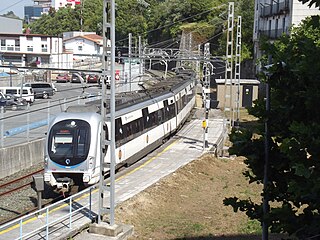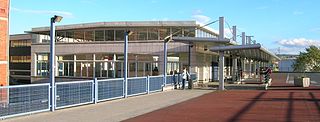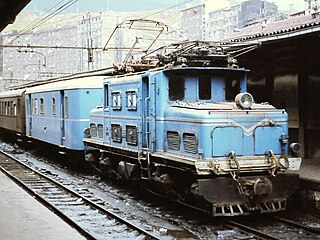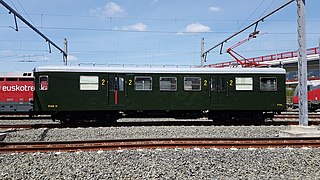
Rail transport in Spain operates on four rail gauges and services are operated by a variety of private and public operators. The total route length in 2012 was 16,026 km.

Euskotren Trena, formerly known just as Euskotren is a commuter, inter-city and urban transit train-operating company that operates local and inter-city passenger services in the provinces of Biscay and Gipuzkoa, in the Basque Country, Spain. It is one of the four commercial brands under which Euskotren operates, as a public company managed by the Basque government. The entire 181.1-kilometre (112.5 mi) network uses 1,000 mm narrow gauge rail tracks which have been owned by the Basque Government since their transferral from the Spanish government; the rail tracks and stations were part of the FEVE network until its transferral. Euskotren Trena also operates the Donostia/San Sebastián metro under the brand Metro Donostialdea.

Bilbao-Atxuri is a former terminal railway station in Bilbao, Basque Country (Spain). It served as the terminus station for the commuter rail trains of Euskotren Trena lines to Durango, Bermeo, Eibar and Donostia for over one hundred years.

Leioa is a station on line 1 of the Bilbao metro. It is located in the neighborhood of Udondo, in the municipality of Leioa. The station opened as part of the metro on 11 November 1995, replacing an older station. It is located next to a park and ride facility.

Euskotren operates frequent commuter rail services in the city of San Sebastián and the surrounding Donostialdea area, in the Basque Country, Spain. The infrastructure is gradually being upgraded to rapid transit standards, in order to create the San Sebastián Metro. The line is commonly known as Topo, due to the large number of tunnels present. As of 2021, the San Sebastián suburban rail services are branded as part of the Euskotren Trena network, with no separate identity.

The Comodoro Rivadavia and Colonia Sarmiento Railway was an Argentine railway company that built and operated a broad gauge line that connected the port of Comodoro Rivadavia with Colonia Sarmiento in Chubut Province. The FCCRCS -belonging to Argentine State Railway- also connected to Central Chubut Railway.

The Euskotren 3150 series is a railcar train type formerly operated by Euskotren in the Basque Country, Spain. Originally built in the 1960s by Ferrocarriles Vascongados, the series was retired from passenger service in 1997. A refurbished unit, known as Trenbiker, is operated by Euskal Trenbide Sarea as a track geometry car.

The Brown Boveri electric locomotive was an electric locomotive type originally operated by Ferrocarriles Vascongados in the Basque Country, Spain. When that company was absorbed by FEVE, it came to be known as the FEVE 4000 series. It was later operated by Euskotren.

The Euskotren 200 series is an electric multiple unit (EMU) train type operated by Euskotren in the Basque Country, Spain from 1986 to 2018.

The Urdaibai line, also known as the Amorebieta-Bermeo railway is a 29.19 km (18.14 mi) mostly single-track branchline in Biscay, Basque Country. Owned by Euskal Trenbide Sarea, it runs from Bermeo to Amorebieta, connecting with the Bilbao-San Sebastián mainline.

Amara is a railway station in San Sebastián, Basque Country, Spain. It is owned by Euskal Trenbide Sarea and operated by Euskotren. It is the eastern terminus of the Bilbao-San Sebastián line and is also served by the suburban Topo service.

The ASEA electric locomotive was an electric locomotive type originally operated by Ferrocarriles Vascongados in the Basque Country, Spain. When that company was absorbed by FEVE, it came to be known as the FEVE 4100 series. It was later operated by Euskotren.

The ASEA electric locomotive was an electric locomotive type originally operated by Ferrocarriles Vascongados in the Basque Country, Spain. When that company was absorbed by FEVE, it came to be known as the FEVE 4200 series. It was later operated by Euskotren.
Euskotren is a public railway operator in the Basque Country, Spain. Its rolling stock is formed by electrical multiple units used for Euskotren Trena commuter rail services, trams running on the Bilbao and Vitoria-Gasteiz tramway networks, and locomotives for hauling freight trains.

Ferrocarriles Vascongados was a railway company in the Basque Country, Spain; founded in 1906 as the merger of three railway companies. It operated the Bilbao-San Sebastián line, as well as the Elorrio branch and the Deba railway. FEVE took over its operations in 1972, which in 1982 were transferred to the new company Basque Railways. Ferrocarriles Vascongados was dissolved in 1995, after more than two decades without activity.

The long Ganz railcar is a railcar train type formerly operated by Ferrocarriles Vascongados in the Basque Country, Spain from 1928 to 1981.

The 130T was a steam locomotive type originally operated by Ferrocarriles Vascongados in the Basque Country, Spain. One of the locomotives, named Aurrera, has been preserved at the Basque Railway Museum and is used regularly to haul heritage trains.
Ferrocarriles y Transportes Suburbanos, commonly known by its acronym FTS, was a railway company in the Basque Country, Spain. Founded in 1947 as the merger of various railway companies, it operated several suburban rail lines in the Greater Bilbao area. FEVE took over its operations in 1972, which in 1982 were transferred to the new company Basque Railways.

The FEVE 3500 series is an electric multiple unit (EMU) train type operated by Renfe Feve in Spain. The first units entered service in the Basque Country in 1977, these trains were later transferred to Euskotren, where they were known as the Euskotren 3500 series. Euskotren retired its last 3500 trains in 2013, but some units are still in service in Asturias.

The Carde y Escoriaza railcar is a railcar train type formerly operated in the Basque Country, Spain. They were introduced in the Bilbao-Plentzia railway in 1927, and were later operated by Ferrocarriles y Transportes Suburbanos, Euskotren, Metro Bilbao and Euskal Trenbide Sarea until 2012.


















